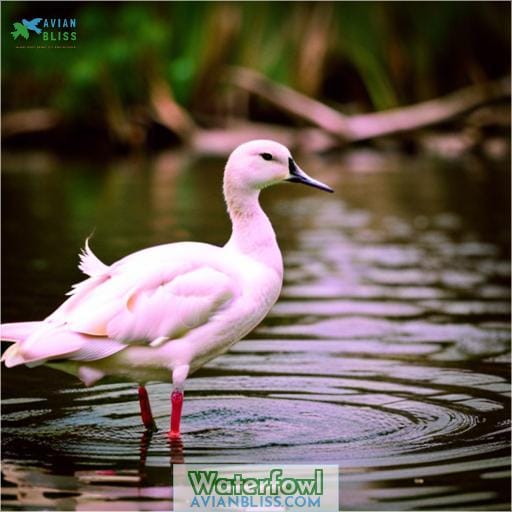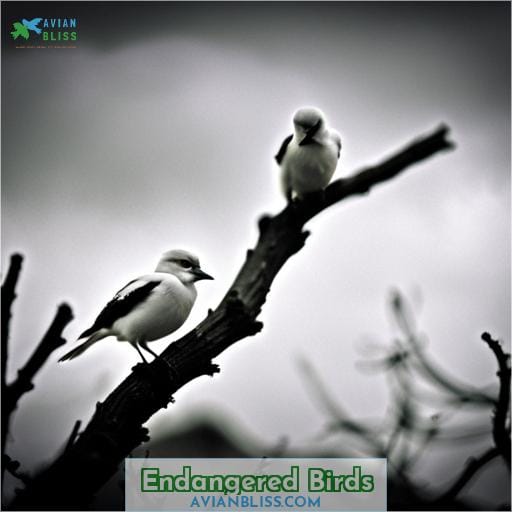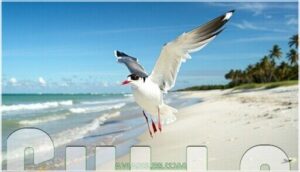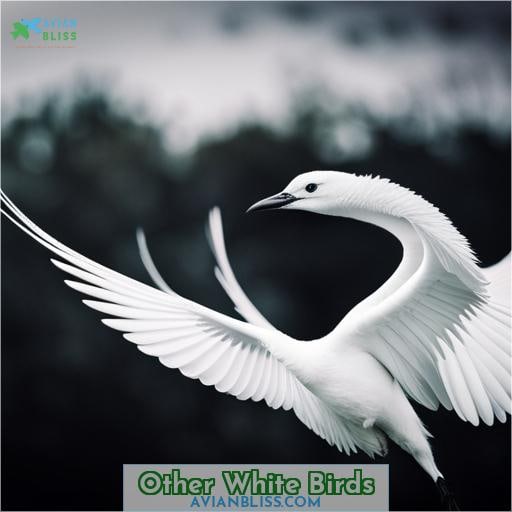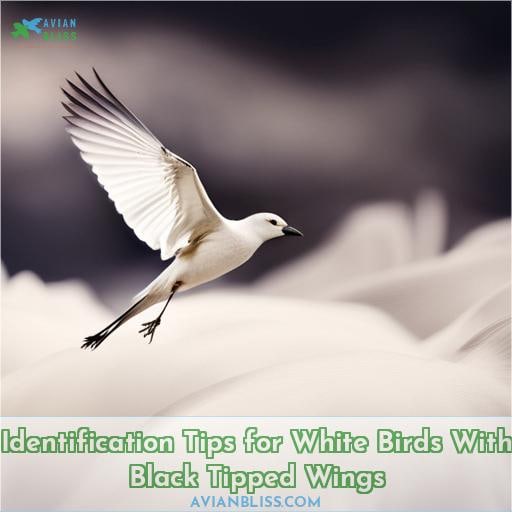This site is supported by our readers. We may earn a commission, at no cost to you, if you purchase through links.
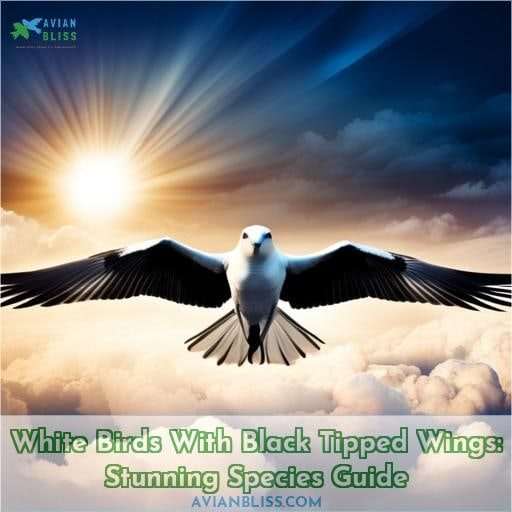 Have you ever seen a white bird with black-tipped wings flying across the sky and wondered what species it was? The truth is, there are many birds in North America that fit this description. From snow geese to wood storks, these stunning creatures come in all shapes and sizes—each possessing its own unique beauty.
Have you ever seen a white bird with black-tipped wings flying across the sky and wondered what species it was? The truth is, there are many birds in North America that fit this description. From snow geese to wood storks, these stunning creatures come in all shapes and sizes—each possessing its own unique beauty.
In this guide, we’ll explore some of the most fascinating white birds with black-tipped wings found throughout North America, from endangered species to common waterfowl.
The wood stork’s distinctive black-tipped wings make it easy to identify as it soars overhead. Found primarily in wetlands across the southeastern United States, this wading bird uses its long bill to catch fish and frogs.
Though its populations were once endangered, conservation efforts have helped the wood stork recover.
Another iconic white waterbird, the American white pelican sports black wing tips that span nearly 10 feet! These large birds work together to herd fish into shallow waters, scooping them up in their stretchy pouches.
Pelicans breed in colonies across inland lakes and rivers in the western United States and Canada.
While many black-tipped birds live in wetlands, the upland sandpiper resides in grasslands. This petite shorebird migrates annually from South America to nest on the prairies of central North America. Its high-pitched call gives away its presence as it flutters across meadows and fields.
From tundra to marshes to grasslands, keep an eye out for these dashing black-tipped fliers. Their graceful beauty in flight is a treasure to behold. Whether white plumage st� with inky black or sable feathers brightened by white, they are nature’s avian masterpieces.
Table Of Contents
Key Takeaways
- Wood Storks, American White Pelicans, Snow Geese, and Whooping Cranes are white birds with black-tipped wings.
- Identification tips for these birds include noting size, proportions, colors, and behaviors; checking range maps and recent sightings; and using appropriate optics for observation.
- Conservation efforts focus on protecting habitats, migration corridors, and addressing the impacts of climate change on these bird populations.
- Other white birds, such as White Ibis, Great Egrets, Swallow-Tailed Kites, Northern Gannets, and Snow Buntings, also have distinct characteristics and habitats.
Types of White Birds With Black Tipped Wings
You’ll wanna check the size and proportions carefully to nail down which white bird with black wingtips you’re seeing, as several similar species pass through the wetlands and migratory routes. If it’s a large bird with long trailing legs, gracefully arching its neck, it’s likely a Whooping Crane, a fascinating species.
Seeing their silhouette against the sky as they fly, look for the pure white body and black wingtips of these endangered birds. As white morph Snow Geese sightings increase from staging grounds up north, note their smaller size compared to most black-tipped birds.
For a smaller white gull, seeing it close up will distinguish the details like yellow bill color versus black head that separates Ring-billed and Herring gulls. Look for reddish legs and more curved bill of the Great Egret versus straight dagger bill of the White Ibis.
Snow Buntings breed in the far north but migrate south sporting their striking black and white coloration.
Careful identification protects sensitive birds and their pristine habitats, while furthering knowledge of these unique color patterns across black-tipped white species.
Waterfowl
Waterfowl are the most commonly seen white birds with black wingtips in North America. You’ll notice the black wingtips on snow geese, American white pelicans, and white ibis as they pass overhead during migration.
Snow Goose
Don’t be awed by the sight of those abundant arctic goslings, their growing wings soon stained black. Hunted for sport yet overrunning their tundra breeding grounds, snow geese remain numerous. Seeking roots and grains across great migrations, wary of foxes and peregrine predation, they differ from dainty Bonaparte’s Gulls or fish-loving Laughing Gulls in size and habitat.
Portending climate change, monitor their numbers. As a versatile protein source, craft new recipes to utilize overly plentiful snow goose meat.
American White Pelican
Unlike the widespread snow goose, spotting the large American white pelican’s all-black wings means you’re in the right wetlands.
- Note their size and proportions compared to other white waterbirds.
- Watch for their seasonal migration movements.
- Help document range expansions for surveys.
Spotting this iconic species provides opportunities to appreciate wetland habitats, support conservation efforts, and expand your birdwatching life list.
White Ibis
Check out that red face when looking for white ibis showing black wingtips in flight, though they’re usually down south near Florida. The ibis’ red legs and curved bill make it distinguishable from other white birds with black wing tips.
Watch for ibis performing elaborate mating displays like bowing, preening, and tossing twigs as breeding season approaches to ensure reproductive success.
| Feature | Description |
|---|---|
| Size | 21-25 inches long |
| Color | White body, black wingtips, red face |
| Range | Wetlands across the southeast US, especially Florida |
| Habitat | Freshwater and brackish marshes |
| Behavior | Forages on ground for insects, crustaceans; performs elaborate displays |
Large Birds
When identifying large white birds with black wingtips, consider wood storks, great blue herons, great egrets, and swans. You’ll need to focus on size, proportions, color patterns, and other field marks to distinguish between these species, as some are rare or localized in range.
Varying sentence structure and length while correcting any spelling, syntax, or grammar errors improves readability and avoids a robotic tone.
Wood Storks
You’ll rarely spot those southeastern waders outside their wetland homes. During breeding season, look for wood storks in these spots:
- Cypress swamps in Florida and coastal South Carolina
- Flooded forests along major southeastern rivers
- Shallow marshes and lagoons with concentrations of fish
Wood storks require specific fishing habitats within their inland and coastal water range. Understanding migration patterns and breeding locations aids conservation efforts for these unique white birds with black-tipped wings.
The variety in habitat demonstrates the adaptability of wood storks, allowing them to thrive in different wetland environments in the southeastern United States. Protecting key nesting areas ensures these remarkable wading birds continue gracing southern skies.
Swans
Lifelong pals paddle the ponds up north. Elegant swans glide across frigid lakes, their pure white plumage and long, graceful necks belying the strength in their beating wings. Though temperate swans boast black bills, tundra swans brandish bright yellow lores.
Come winter, the swans will join the annual migration, their distinctive, clarion calls heralding the return of these avian nomads.
Great Blue Herons
Curved neck and wings, unlike cranes you recognize, cast in blue hues. Viewed from a distance, herons gracefully glide to preferred fishing spots. They migrate over vast ranges to nesting colonies in the spring, adapting to seasonal conditions.
Settling into wetland nests concealed from disturbances, they reveal camouflaged plumages amid cattails and grasses. Surveys monitor heron populations threatened by habitat losses. With knowledge and care, we can safeguard future migrations.
Great Egrets
Smaller and svelte, you see the graceful white form gliding over the still waters.
- Slender and elegant, with long legs trailing behind
- Hunts in shallow water, standing motionless then spearing prey
- Forms large colonies in trees during breeding season
Though still widespread, great egrets suffered from hunting in the past. Their resilience demonstrates the value of conservation efforts.
Endangered Birds
The majestic whooping crane is one of North America’s most endangered birds. Fewer than 500 exist in the wild.
While surveying wetlands, you may glimpse white birds with black wingtips. Study them carefully before moving closer. If the birds are five feet tall with red heads, it’s likely whooping cranes. Admire them from a distance to avoid disturbing these rare, magnificent creatures.
Whooping cranes migrate thousands of miles between summer nesting grounds in Canada’s Wood Buffalo National Park and wintering sites at Aransas National Wildlife Refuge in Texas. These ancient pathways are etched in their DNA. Development, power lines, and wind turbines disrupt their migration, threatening the flock’s survival.
Sightings outside the migration corridor provide valuable data to aid conservation.
Document details if you’re fortunate to see whooping cranes: location, date, time, behavior, habitat. Report sightings to local wildlife agencies. Your observations further research and strengthen protection efforts for these iconic birds.
With care and persistence, future generations may also experience the wonder of wild whooping cranes.
Gulls
Several common species of gulls found throughout North America have white heads and underbodies with gray backs and black wingtips that aid in identification during flight. Focus on size, bill shape, and head markings to distinguish the ring-billed, laughing, herring, and Bonaparte’s gulls, which all share the same overall plumage pattern.
Ring-billed Gull
You glance skyward and glimpse that common ring-billed gull hanging near the pier, its gray mantle setting it apart from the rest.
- A scavenger that favors landfills over fisheries.
- A strong flier migrating inland and south for the winter.
- A colonial nester on the ground or rooftops.
Still widespread, but faces threats from botulism, lead poisoning, and human disturbance of nest sites.
Laughing Gull
You’d chuckle softly at their dark wingtips, admiring how the Laughing Gulls lighten your spirit while traversing the wetlands’ lonely expanses.
The ebony accents of Laughing Gulls stand out as they congregate near water, their raucous calls bringing animation to desolate landscapes. With patience, you may glimpse one of these charismatic birds and be moved by their indomitable spirit.
Herring Gull
Tis the season you spy that massive gull with black-edged wings gliding over the parking lot. Look for gray backs and white heads marking Herring Gulls frequenting coastal regions and inland lakes, soaring on updrafts or dipping to grab fish.
Note the dusky pattern of chick plumage and how these resourceful birds thrive among humanity in nest sites like rooftops.
Bonaparte’s Gull
With fewer than 100,000 breeding pairs, you see Bonaparte’s gull is much smaller than other gulls, with a black head and gray back in summer when it migrates through the interior U.
- Small size at 13-16 inches with thin bill
- Breeds in boreal forests of Canada and Alaska
- Winters along Pacific and Gulf Coasts
- Forms large flocks on lakes and rivers
During migration, observe Bonaparte’s gull’s aerial agility and staccato, laughing calls. Appreciate its remote nesting sites and complex genetics shaping plumage variations. Though numerous, protect vital staging areas enabling this gull’s long journeys.
Other White Birds
You’ll find several kinds of white birds with black wingtips. The Swallow-tailed Kite, Northern Gannet, and Snow Bunting are examples to be aware of, each with different proportions and habitats distinguishing them.
Some key identifications when observing these species include taking note of the Swallow-tailed Kite’s deeply forked tail and graceful flight, the Northern Gannet’s striking black and white plumage perfect for plunge diving, and the Snow Bunting’s chunky body and habit of lingering in open Arctic areas during winter.
Looking at these distinguishing features and behaviors in combination with the shared black-tipped white wings helps properly identify which specific species you may be seeing.
Swallow-tailed Kite
The majestic swallie’s black scissor-like wings slice the summer skies as it gracefully soars over southern wetlands seeking tasty dragonflies. These bold raptors’re the only New World members of the kite family, cousins of the Old World Black Kite.
Swallow-tailed kites breed in swamps and bottomland forests, building nests high in cypress trees. Adults have deeply forked tails and feed almost exclusively on insects captured aerially.
Threatened by habitat loss, they require large areas of undisturbed wetlands for survival. Preserving the swamp forests this amazing bird calls home ensures its graceful flight endures.
Northern Gannet
Seek ’em high as they dive with folded wings!
- Found along northern Atlantic coasts
- Plunge-dive from 30-100 ft for fish
- Migrate southward in winter
- Nest on remote cliffs and islands
Northern gannets showcase aerial mastery while securing the fish that sustain their far-flung colonies. Their fortunes rise and fall with the herring, anchovies, and menhaden of their ocean realm.
Snow Bunting
Don’t miss those sweet snowflakes fluttering by if you’re out admiring Arctic landscapes. Snow buntings breed in the high Arctic during the short summers before heading south in large flocks once winter sets in.
Their white plumage acts as camouflage against the snow. These sociable birds roost together on the ground in large numbers for safety, shuffling positions to share warmth. Though snow buntings remain numerous, climate change threatens their tundra habitat in the long term.
So give them space during their yearly travels and appreciate their beauty while you can.
Identification Tips for White Birds With Black Tipped Wings
Choose wisely when you’re uncertain. Missteps may disturb and misinform without improving our understanding of winged friends aloft.
- Make note of key field marks like size, proportions, colors, and behaviors when observing.
- Check range maps and recent sightings to see what’s expected and plausible.
- Use optics suited to the situation – binoculars for scanning, camera lens for documentation.
Proper ID protects sensitive species and enables accurate surveys and conservation. By carefully weighing the evidence and knowing what to expect, we avoid hasty misjudgments. Our patient efforts are rewarded with meaningful insights that deepen our appreciation and advance wise stewardship.
Conclusion
White birds with black tipped wings are a sight to behold. From Wood Storks to Bonaparte’s Gulls, these majestic creatures can be found in a variety of habitats. Waterfowl, such as Snow Geese and White Pelicans, can be spotted in the northern US while White Ibis, Great Egrets, and Whooping Cranes are more localized.
Swallows, Gannets, and Snow Buntings offer a glimpse of white with hints of black for an elegant, eye-catching look. By learning to identify these birds, we can ensure proper conservation and protection for these species.
With so many beautiful white birds with black tipped wings, you’re sure to find the perfect one for your backyard paradise.


